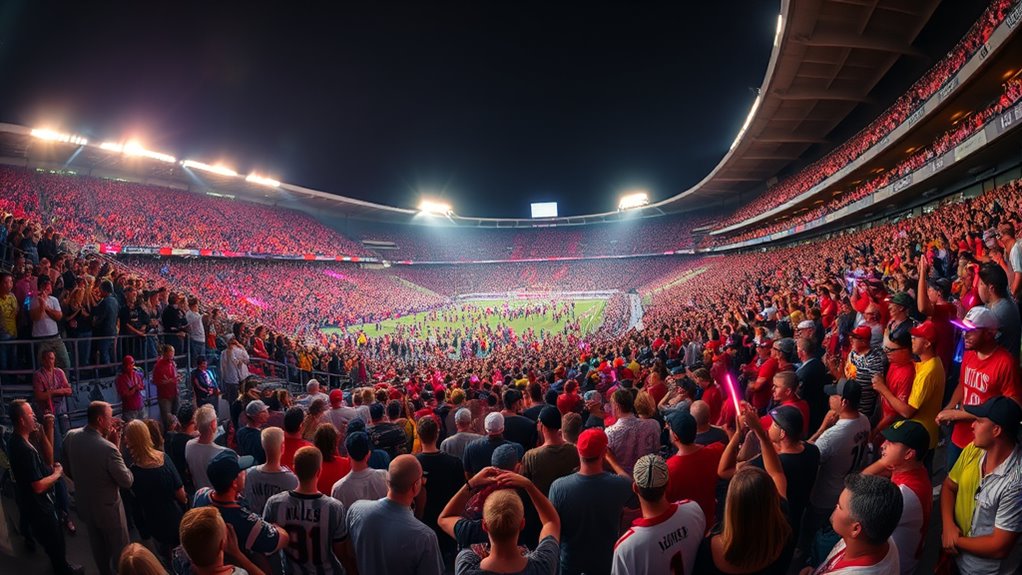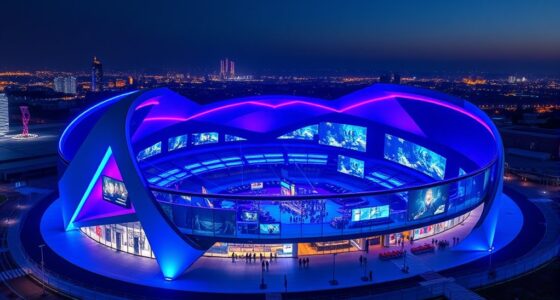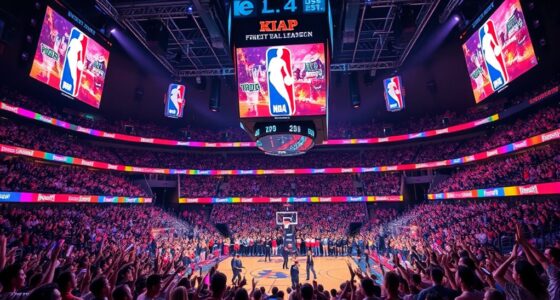Over the past 120 years, sports fans have shifted from cheering in stadium terraces to engaging through digital platforms like Twitch. Early fans enjoyed live attendance, organized supporter groups, and radio broadcasts that brought games into homes. Today, technological advances such as streaming, AR, and virtual events create immersive and global fan experiences. If you look further, you’ll see how these innovations continue to change the way fans connect and celebrate their passions.
Key Takeaways
- Fan engagement has evolved from in-person attendance and supporter groups to digital and virtual platforms.
- Technological advances like radio, TV, and social media expanded access and created shared viewing experiences.
- Augmented reality and immersive tech now enable interactive, personalized fan experiences beyond stadiums.
- Virtual participation, digital collectibles, and online events increasingly connect global fan communities.
- The progression reflects a shift from physical terraces to global, digitally connected streaming platforms like Twitch.
The Early Days of Spectator Sports and Live Attendance

In the earliest days of spectator sports, live attendance was the primary way fans connected with their favorite games. Back then, fans learned basic spectator etiquette, such as respecting others’ views and keeping noise to a reasonable level. Ticket pricing was often affordable, encouraging widespread attendance, but it could vary depending on the event’s popularity or location. You’d buy a ticket at the gate or from local vendors, making watching a game a community affair. Still, attending in person meant you were part of the vibrant atmosphere, sharing the thrill and energy with fellow fans. Unlike today’s digital options, these live experiences created a direct, tactile connection to the sport, shaping the passionate fan culture that persists today. Creating a sense of community engagement was essential to fostering loyalty among spectators and ensuring the continued popularity of live sports events.
The Rise of Fan Clubs and Organized Supporter Groups

As sports grew in popularity, fans began to organize into dedicated groups that showed unwavering support for their teams. These supporter groups developed unique fan club traditions, creating a sense of identity and community among members. Supporter group branding became a key element, with groups adopting distinctive flags, chants, and symbols to stand out and foster pride. This organization allowed fans to coordinate cheers, displays, and away game support, elevating the matchday experience. Over time, these groups became more structured, sometimes forming official affiliations with clubs, and even influencing team culture. You can see how these early supporter groups laid the foundation for modern fan engagement, transforming passionate spectators into organized communities that help shape the sport’s atmosphere. Additionally, the use of Free Floating in their displays and routines helped create dynamic and adaptable support, further energizing the crowd.
The Impact of Radio Broadcasts on Fan Engagement

Radio broadcasts revolutionized how fans connect with their teams by bringing live action directly into their homes and communities. With radio commentary, you could experience the thrill of matches no matter where you were, widening the broadcast reach markedly. This innovation allowed fans to stay engaged during away games and in remote areas, fostering a deeper sense of community and loyalty. The immediacy and accessibility of radio coverage made supporting your team more personal and continuous. Additionally, color accuracy in broadcasts helped convey the true intensity of the game through vivid audio cues, further enhancing the viewing experience. Below is a table illustrating key aspects of this impact:
| Aspect | Effect | Example |
|---|---|---|
| Broadcast Reach | Expanded to rural and international areas | Global listening audiences |
| Commentary Style | Brought excitement and insights | Real-time analysis |
| Fan Engagement | Increased match-day involvement | Listening during commutes |
| Accessibility | Allowed support without attending | Fans at home or work |
| Community Bonding | Strengthened regional support | Shared experiences |
The Television Era: Bringing Games Into Living Rooms

The advent of television transformed how fans experience sports by bringing live games directly into their living rooms. No longer confined to stadiums, you could now watch matches from home, fostering a new sense of connection. Fan memorabilia, such as jerseys and signed balls, gained popularity as keepsakes, deepening your emotional bond with teams. Stadium architecture also evolved, with designs emphasizing better camera angles and viewing comfort for TV audiences. This shift made sports more accessible, broadening fan bases beyond the local terraces. Families and individuals could now engage with their favorite teams daily, creating shared traditions around televised matches. Additionally, the rise of meditation techniques helped fans cope with the intense emotions tied to game outcomes, promoting mental well-being amid sporting passions. The television era truly revolutionized fan culture, making sports a national, even global, pastime.
The Digital Revolution: Internet and Online Fan Communities

The digital revolution has transformed how fans connect and engage with their favorite sports by shifting interactions online. You now share your passion through virtual memorabilia, collecting digital items like jerseys, highlights, and signed moments, creating a personalized fan archive. Online betting has also become a major part of this shift, allowing you to place bets instantly and engage more actively with games. These platforms foster communities where you discuss strategies, celebrate victories, or analyze performances in real-time. The internet enables you to follow your team’s news, watch live streams, and participate in forums, making fandom more accessible and interactive than ever before. Additionally, advancements in technology have improved the quality and accessibility of digital content, further enriching the fan experience. This digital shift deepens your connection, bringing fans closer despite physical distances.
Social Media’s Role in Creating Virtual Fandoms

Social media platforms have revolutionized how fans build and participate in virtual communities around their favorite sports. You now connect with others instantly, sharing your passion through posts, comments, and live chats. Influencer collaborations play a huge role, as popular sports personalities and online celebrities boost engagement and bring fans together. Meme culture thrives, creating shared humor and inside jokes that strengthen community bonds. These memes often go viral, spreading jokes and highlights across platforms, making fandom more interactive and entertaining. Additionally, the use of eye patches in promotional content or fan art adds a layer of visual symbolism that can deepen fan engagement. Social media transforms passive spectators into active participants, allowing you to celebrate victories, voice opinions, and engage in debates from anywhere. This digital environment fosters a sense of belonging, turning casual viewers into dedicated virtual fans who feel connected beyond traditional stadiums.
Streaming Platforms and On-Demand Content

Streaming platforms and on-demand content have transformed how fans consume sports, giving you the flexibility to watch games whenever and wherever you want. No longer confined to stadiums or TV schedules, you can access live matches, highlights, and classic games at your convenience. This shift has also impacted fan memorabilia collection, as fans now cherish digital collectibles alongside physical items. Additionally, stadium architecture plays a role, as fans increasingly prefer watching from home or on mobile devices, reducing the need for traditional venues. You can now enjoy immersive viewing experiences, often with multiple camera angles and commentary options. These advances democratize sports fandom, making it easier to stay connected to your favorite teams and players without geographic or temporal constraints. Moreover, the integration of arcade machine gaming experiences into entertainment venues offers nostalgic and interactive ways for fans to engage with sports culture beyond traditional viewing.
Interactive Technologies and Augmented Reality Experiences

Interactive technologies and augmented reality are transforming how you experience live sports. AR enhances your viewership by making it more immersive and engaging, blurring the lines between fans and the game. As these innovations grow, they’ll change the way you connect with your favorite teams and moments. For example, TDI tuning techniques can be adapted to optimize AR hardware performance, ensuring seamless and responsive user experiences.
AR Enhances Live Viewing
Have you ever wondered how augmented reality is transforming the way fans experience live sports? AR brings the game closer by overlaying stats, player info, and replays right onto your view, making each moment more engaging. Fans now use AR to explore virtual fan merchandise, customizing gear or viewing 3D models before buying. This technology also influences ticket pricing, offering enhanced experiences at different price tiers—VIP packages include AR features that deepen engagement, justifying higher costs. Live viewing becomes more interactive, allowing you to see real-time data or behind-the-scenes content without missing vital plays. AR elevates your experience, making attending games more immersive and personalized, ultimately strengthening your connection to the sport and your favorite teams. Additionally, the integration of nutritional benefits from juice-based products reflects the broader trend of enhancing fan health and wellness through innovative technology.
Immersive Fan Engagement
Augmented reality has opened new doors for fans seeking deeper, more personalized connections to their favorite sports. With immersive technologies, you can now explore stadium architecture virtually, walking through iconic venues or experiencing historic moments firsthand. This tech taps into fan nostalgia, allowing you to relive memorable plays or relive past seasons in a new way. Interactive AR experiences boost engagement by making you feel part of the action, whether through virtual overlays during live games or personalized content tailored to your preferences. These innovations transform passive spectators into active participants, enhancing the emotional bond with teams and venues. Additionally, costume ideas from The Office and themed merchandise further personalize the fan experience, strengthening emotional connections. As AR continues evolving, it promises even more immersive ways to connect, deepen loyalty, and celebrate sports history like never before.
The Future of Fan Participation and Virtual Events

As technology continues to advance, virtual events are becoming an integral part of how fans engage with their favorite teams and athletes. You can now participate in virtual cheerleading sessions, where you lead cheers alongside other fans from around the world, creating a shared sense of excitement. Virtual meet-and-greets and live-streamed games allow you to connect more directly, no matter where you are. Digital memorabilia offers a new way to celebrate your fandom, with limited-edition digital collectibles and collectibles that you can display online. These innovations make fan participation more immersive and personalized, bridging the gap between physical attendance and remote engagement. Additionally, advancements in outdoor living technology are enhancing the fan experience outside the stadium, making tailgating and outdoor viewing areas more comfortable and interactive. The future will likely see even more interactive experiences, giving you new ways to support and celebrate your team.
Cultural Shifts and the Globalization of Fandom

As digital platforms connect fans worldwide, your sense of community extends beyond local borders. This globalization influences cultural identities, blending traditions with new perspectives. How do these shifts reshape your understanding of fandom and belonging? With TikTok’s extensive reach across over 150 markets and its role in shaping viral trends and cultural exchanges, it exemplifies how short-form video content fosters a global sense of community and shared experience.
Digital Global Fan Communities
The rise of digital platforms has transformed fandom into a truly global phenomenon, allowing fans from different countries to connect instantly and share their passion. You can now join online communities where fan loyalty transcends borders, creating a sense of belonging no matter where you’re from. These platforms enable real-time discussions, live streams, and fan-driven content that keeps you engaged with your favorite teams or artists. Merchandise marketing has also become more targeted, with brands tailoring products to diverse international audiences. This global reach amplifies your influence as a fan, shaping trends and fueling collective enthusiasm. Digital global fan communities break down geographical barriers, making your passion more accessible, personal, and impactful than ever before. Additionally, fostering cultural intelligence within these communities enhances mutual understanding and respect among fans from diverse backgrounds.
Cultural Identity Shifts
Digital platforms have not only connected fans worldwide but also influenced how cultural identities shape and evolve within fandoms. You now see cultural identity shifts happening as fans blend tradition with innovation, creating new ways to express their passions. While some fans cling to long-standing traditions, others embrace modern trends, leading to dynamic cultural changes. This tension between tradition versus innovation sparks debates but also fosters creativity and inclusivity. As globalization spreads fandoms across borders, cultural identities become more fluid, allowing you to adopt diverse practices while still honoring your roots. These shifts reflect an evolving landscape where cultural identities are no longer static but continuously reshaped by digital interaction and global exchange. Understanding the impact of personality traits can help fans navigate their evolving cultural identities, making their fandom experience richer, more diverse, and more personally meaningful.
Frequently Asked Questions
How Have Fan Demographics Changed Over the Past 120 Years?
You’ve seen how fan demographics have shifted over the past 120 years, influenced by demographic shifts and changing lifestyles. Today, fans are more diverse in age, gender, and background, which affects fan loyalty and engagement. Modern technology and social media also give you easier access to your favorite teams and players, making fandom more inclusive and dynamic than ever before. These changes reshape how you experience and connect with sports.
What Technological Innovations Have Most Significantly Impacted Fan Engagement?
You see, technological innovations like augmented reality and social media platforms have transformed how you engage with sports. Augmented reality brings stadium experiences to your device, making you feel closer to the action, while social media lets you connect instantly with fans worldwide. These tools create more interactive, personalized experiences, making you feel like an active participant rather than just a spectator, revolutionizing your fan journey.
How Do Cultural Differences Influence Global Fandom Behaviors?
Did you know that regional fandom expressions vary widely due to cultural differences? You’ll notice that cross-cultural rituals, like chants and celebrations, shape how fans engage worldwide. These rituals reflect shared values and traditions, influencing behaviors and loyalty. Your understanding of these differences can deepen your connection with diverse fan communities, showing that cultural context drives unique ways fans express passion, transforming global fandom into a vibrant tapestry of regional rituals.
What Role Do Fan-Generated Content and Participation Play Today?
You play a crucial role in today’s fan culture through fan-generated content and participation. Social media platforms let you share your passion, create memes, and engage in fan activism, shaping the narrative around your favorite teams or celebrities. Your active involvement fosters community, influences opinions, and amplifies voices that might otherwise go unheard. This dynamic participation keeps fandom vibrant, connected, and ever-evolving in the digital age.
How Might Future Technologies Further Transform Spectator Experiences?
Future technologies like Augmented Reality and AI Commentary will revolutionize your spectator experience. You might wear AR glasses to see real-time stats, player info, or immersive replays right in your field of view. AI-driven commentary could personalize your viewing, making it more engaging and interactive. These innovations will deepen your connection to the game, making you feel like part of the action, no matter where you’re watching from.
Conclusion
As you’ve seen, fan culture has evolved from cheering in the terraces to tuning into Twitch streams, blending past and future. Just like fans in the 1800s cheered on their teams in person, you now engage through screens and virtual worlds. The journey from handwritten tickets to instant notifications shows how your passion keeps pace with technology. Embrace these changes—you’re part of a vibrant, ever-changing legacy that’s as timeless as a Shakespearean play, but way cooler.








